ABD702: McDonald's Competitive Advantage Analysis and Report
VerifiedAdded on 2023/06/08
|27
|7106
|125
Report
AI Summary
This report provides a comprehensive analysis of McDonald's competitive advantages, focusing on its operations in New Zealand. It begins with an executive summary and background information on McDonald's, followed by a detailed macro-environmental analysis using PESTLE factors (Political, Economic, Social, Technological, Legal, and Environmental) and a micro-environmental analysis including industry characteristics and competition mapping. An internal environmental analysis, including SWOT and VRIO frameworks, assesses the company's strengths, weaknesses, and competitive gaps. The report then outlines strategic choices, performance measurement frameworks, and managerial implications, culminating in a summary and conclusion with recommendations for the company's future. The report uses sources from the provided assignment brief to support its findings. The report concludes with an analysis of McDonald's competitive advantage in the New Zealand market, providing strategic recommendations for improvement and future success in the fast-food industry.
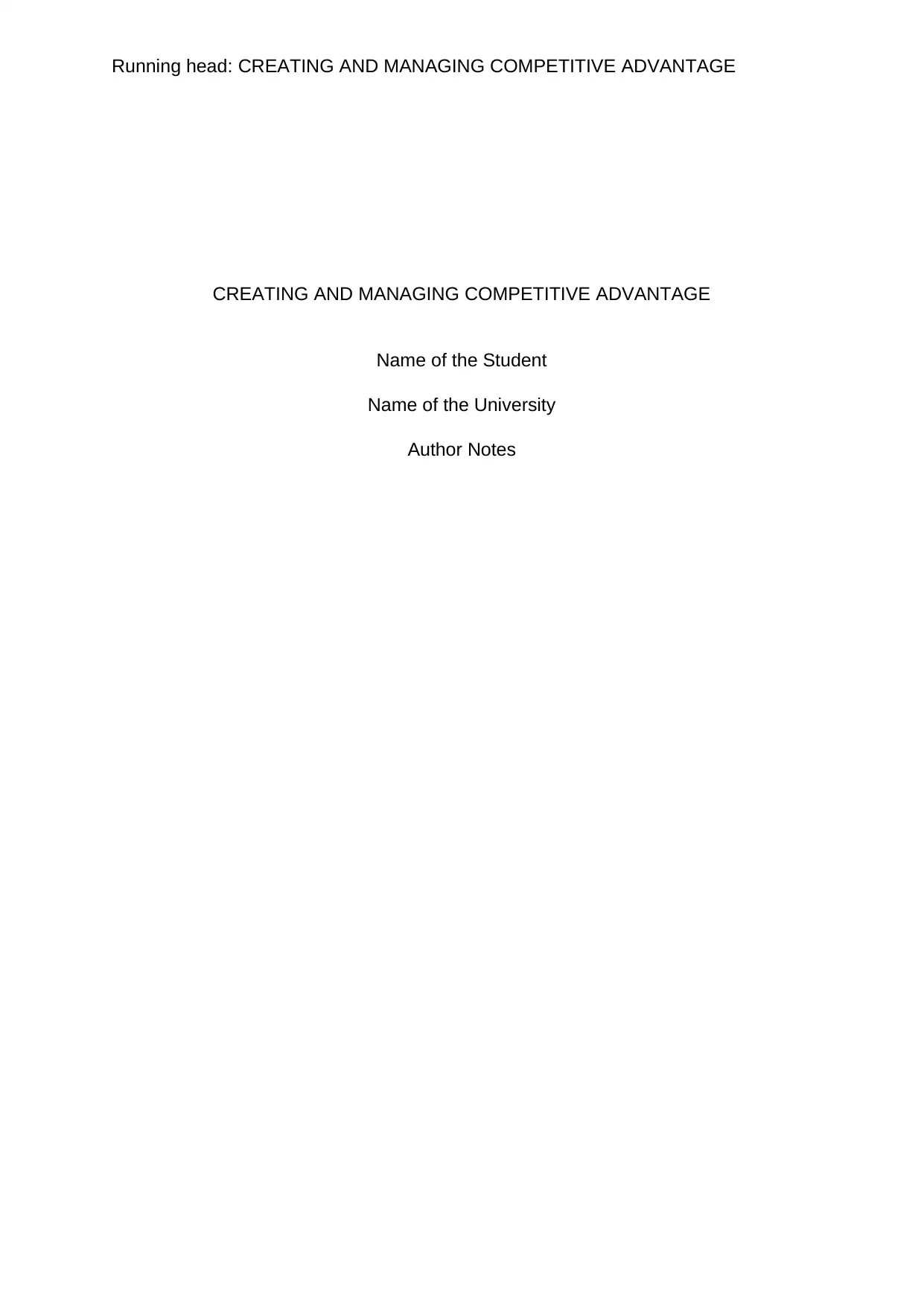
Running head: CREATING AND MANAGING COMPETITIVE ADVANTAGE
CREATING AND MANAGING COMPETITIVE ADVANTAGE
Name of the Student
Name of the University
Author Notes
CREATING AND MANAGING COMPETITIVE ADVANTAGE
Name of the Student
Name of the University
Author Notes
Paraphrase This Document
Need a fresh take? Get an instant paraphrase of this document with our AI Paraphraser
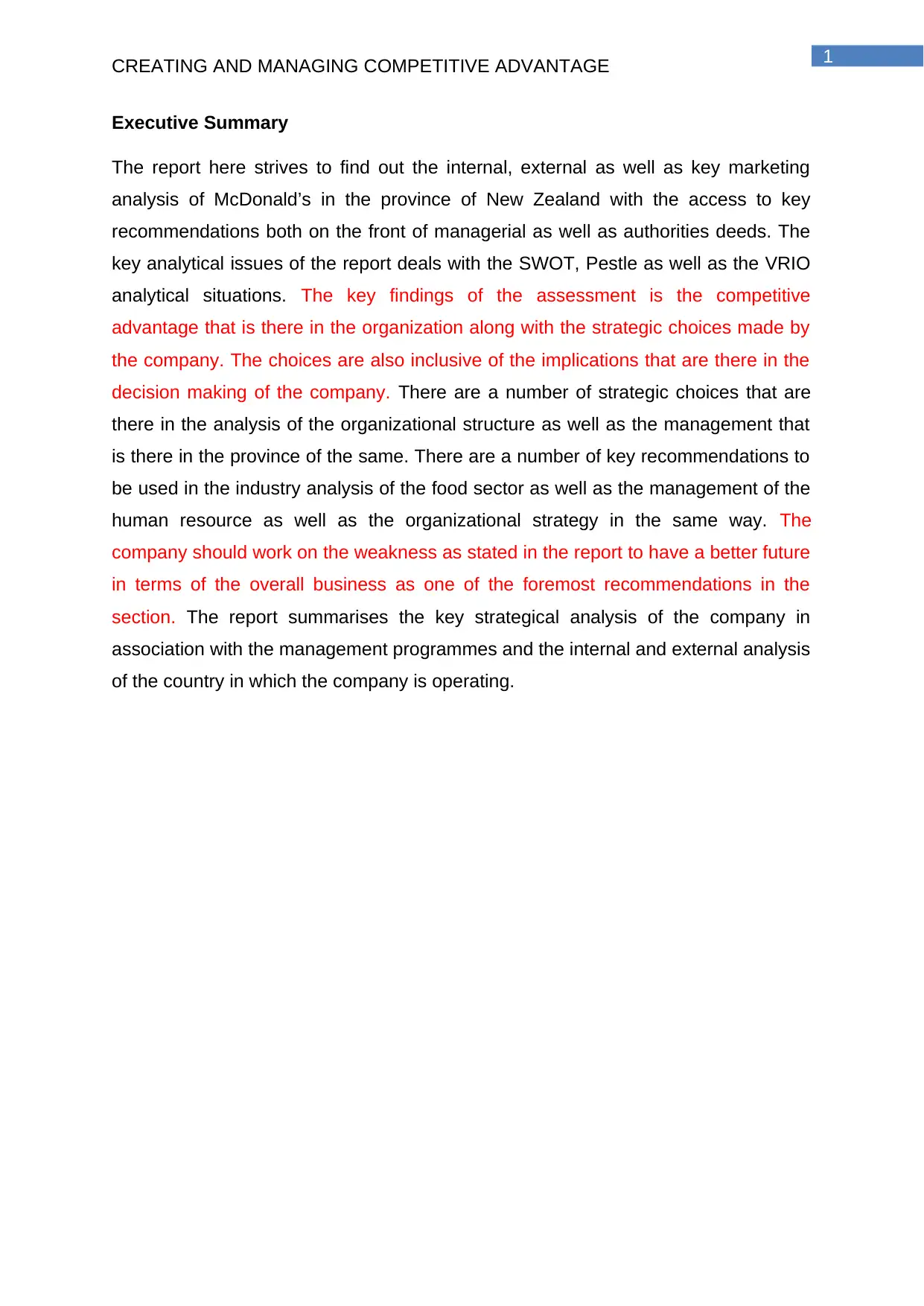
1
CREATING AND MANAGING COMPETITIVE ADVANTAGE
Executive Summary
The report here strives to find out the internal, external as well as key marketing
analysis of McDonald’s in the province of New Zealand with the access to key
recommendations both on the front of managerial as well as authorities deeds. The
key analytical issues of the report deals with the SWOT, Pestle as well as the VRIO
analytical situations. The key findings of the assessment is the competitive
advantage that is there in the organization along with the strategic choices made by
the company. The choices are also inclusive of the implications that are there in the
decision making of the company. There are a number of strategic choices that are
there in the analysis of the organizational structure as well as the management that
is there in the province of the same. There are a number of key recommendations to
be used in the industry analysis of the food sector as well as the management of the
human resource as well as the organizational strategy in the same way. The
company should work on the weakness as stated in the report to have a better future
in terms of the overall business as one of the foremost recommendations in the
section. The report summarises the key strategical analysis of the company in
association with the management programmes and the internal and external analysis
of the country in which the company is operating.
CREATING AND MANAGING COMPETITIVE ADVANTAGE
Executive Summary
The report here strives to find out the internal, external as well as key marketing
analysis of McDonald’s in the province of New Zealand with the access to key
recommendations both on the front of managerial as well as authorities deeds. The
key analytical issues of the report deals with the SWOT, Pestle as well as the VRIO
analytical situations. The key findings of the assessment is the competitive
advantage that is there in the organization along with the strategic choices made by
the company. The choices are also inclusive of the implications that are there in the
decision making of the company. There are a number of strategic choices that are
there in the analysis of the organizational structure as well as the management that
is there in the province of the same. There are a number of key recommendations to
be used in the industry analysis of the food sector as well as the management of the
human resource as well as the organizational strategy in the same way. The
company should work on the weakness as stated in the report to have a better future
in terms of the overall business as one of the foremost recommendations in the
section. The report summarises the key strategical analysis of the company in
association with the management programmes and the internal and external analysis
of the country in which the company is operating.
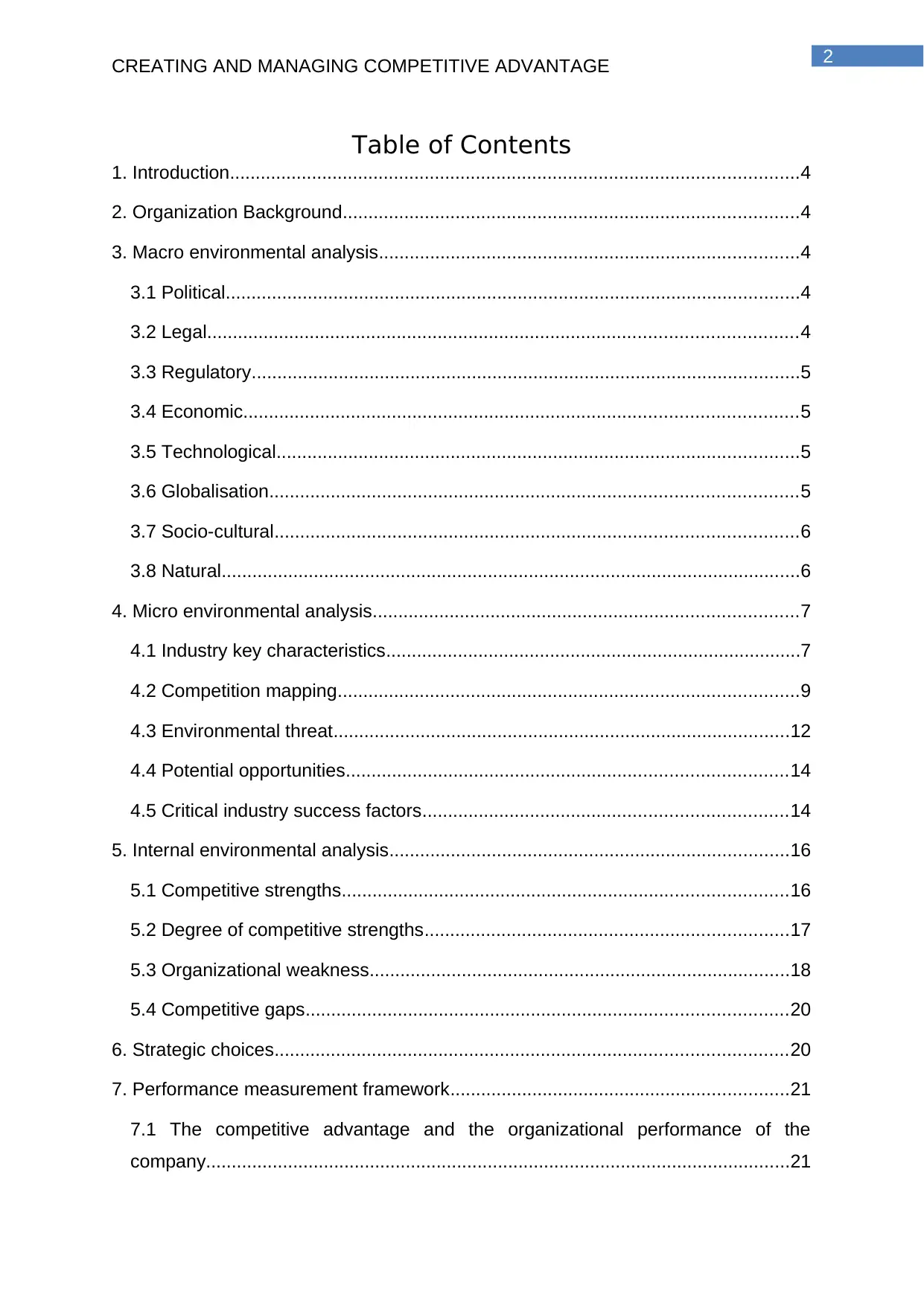
2
CREATING AND MANAGING COMPETITIVE ADVANTAGE
Table of Contents
1. Introduction...............................................................................................................4
2. Organization Background.........................................................................................4
3. Macro environmental analysis..................................................................................4
3.1 Political................................................................................................................4
3.2 Legal...................................................................................................................4
3.3 Regulatory...........................................................................................................5
3.4 Economic............................................................................................................5
3.5 Technological......................................................................................................5
3.6 Globalisation.......................................................................................................5
3.7 Socio-cultural......................................................................................................6
3.8 Natural.................................................................................................................6
4. Micro environmental analysis...................................................................................7
4.1 Industry key characteristics.................................................................................7
4.2 Competition mapping..........................................................................................9
4.3 Environmental threat.........................................................................................12
4.4 Potential opportunities......................................................................................14
4.5 Critical industry success factors.......................................................................14
5. Internal environmental analysis..............................................................................16
5.1 Competitive strengths.......................................................................................16
5.2 Degree of competitive strengths.......................................................................17
5.3 Organizational weakness..................................................................................18
5.4 Competitive gaps..............................................................................................20
6. Strategic choices....................................................................................................20
7. Performance measurement framework..................................................................21
7.1 The competitive advantage and the organizational performance of the
company..................................................................................................................21
CREATING AND MANAGING COMPETITIVE ADVANTAGE
Table of Contents
1. Introduction...............................................................................................................4
2. Organization Background.........................................................................................4
3. Macro environmental analysis..................................................................................4
3.1 Political................................................................................................................4
3.2 Legal...................................................................................................................4
3.3 Regulatory...........................................................................................................5
3.4 Economic............................................................................................................5
3.5 Technological......................................................................................................5
3.6 Globalisation.......................................................................................................5
3.7 Socio-cultural......................................................................................................6
3.8 Natural.................................................................................................................6
4. Micro environmental analysis...................................................................................7
4.1 Industry key characteristics.................................................................................7
4.2 Competition mapping..........................................................................................9
4.3 Environmental threat.........................................................................................12
4.4 Potential opportunities......................................................................................14
4.5 Critical industry success factors.......................................................................14
5. Internal environmental analysis..............................................................................16
5.1 Competitive strengths.......................................................................................16
5.2 Degree of competitive strengths.......................................................................17
5.3 Organizational weakness..................................................................................18
5.4 Competitive gaps..............................................................................................20
6. Strategic choices....................................................................................................20
7. Performance measurement framework..................................................................21
7.1 The competitive advantage and the organizational performance of the
company..................................................................................................................21
⊘ This is a preview!⊘
Do you want full access?
Subscribe today to unlock all pages.

Trusted by 1+ million students worldwide
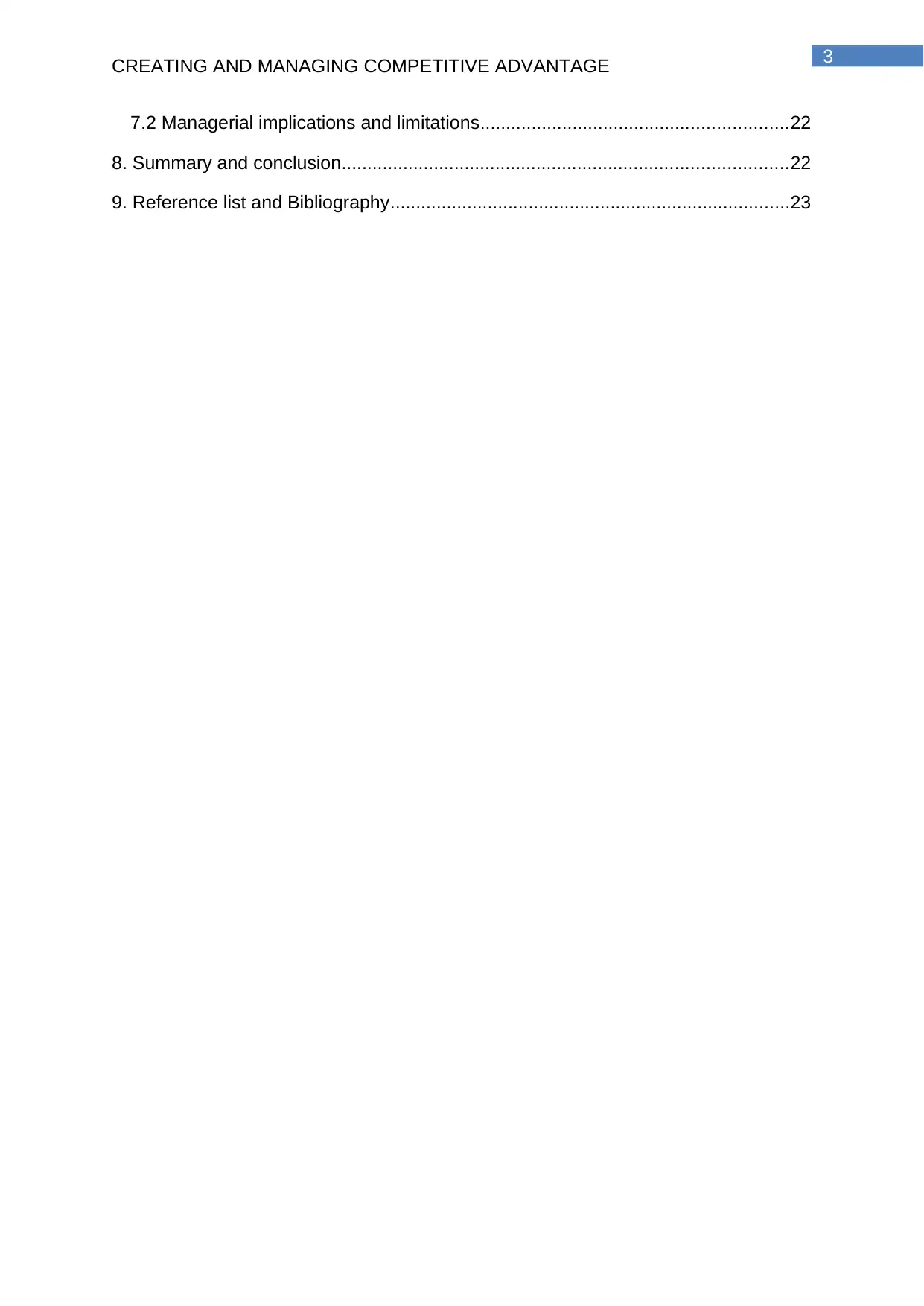
3
CREATING AND MANAGING COMPETITIVE ADVANTAGE
7.2 Managerial implications and limitations............................................................22
8. Summary and conclusion.......................................................................................22
9. Reference list and Bibliography..............................................................................23
CREATING AND MANAGING COMPETITIVE ADVANTAGE
7.2 Managerial implications and limitations............................................................22
8. Summary and conclusion.......................................................................................22
9. Reference list and Bibliography..............................................................................23
Paraphrase This Document
Need a fresh take? Get an instant paraphrase of this document with our AI Paraphraser
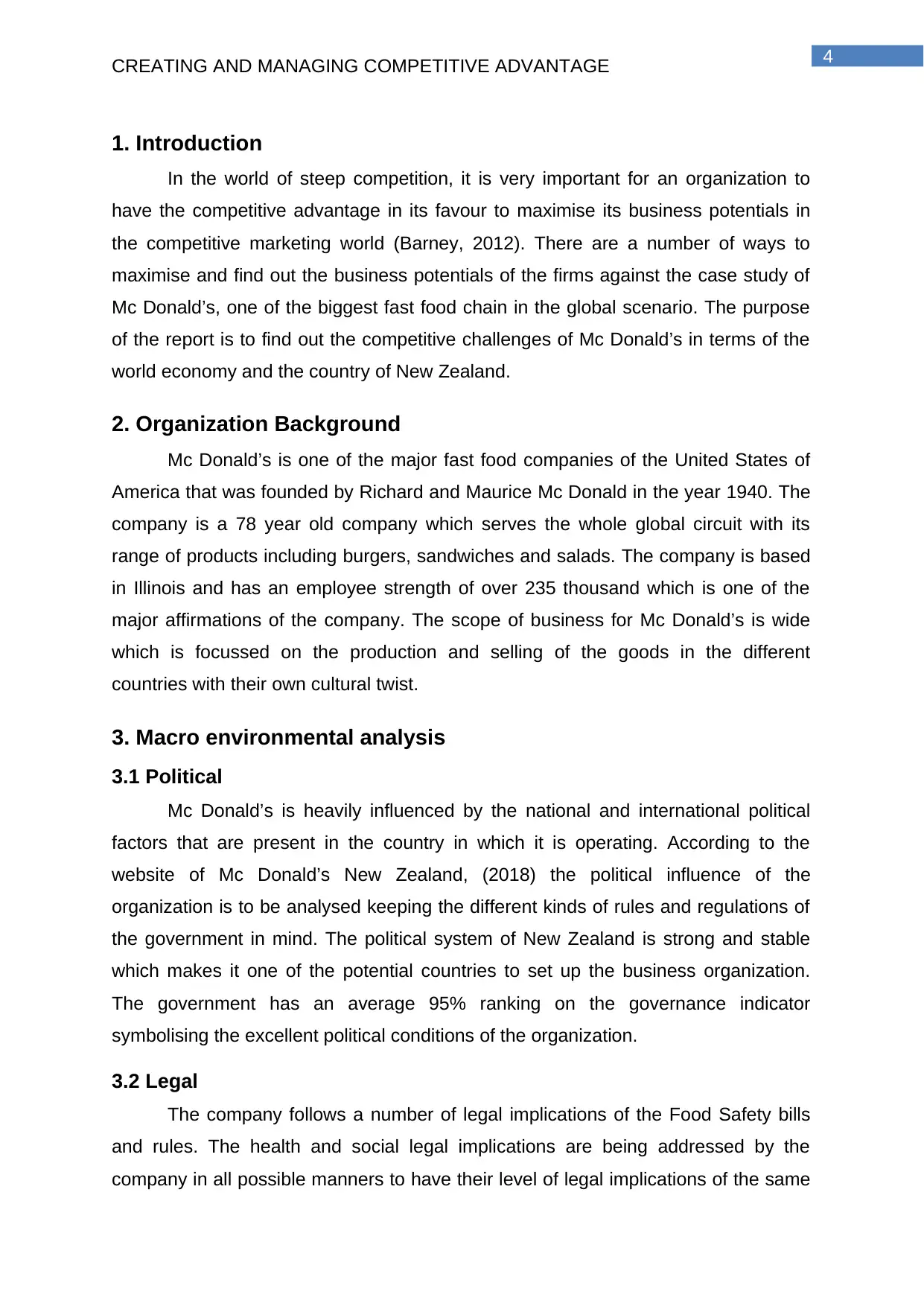
4
CREATING AND MANAGING COMPETITIVE ADVANTAGE
1. Introduction
In the world of steep competition, it is very important for an organization to
have the competitive advantage in its favour to maximise its business potentials in
the competitive marketing world (Barney, 2012). There are a number of ways to
maximise and find out the business potentials of the firms against the case study of
Mc Donald’s, one of the biggest fast food chain in the global scenario. The purpose
of the report is to find out the competitive challenges of Mc Donald’s in terms of the
world economy and the country of New Zealand.
2. Organization Background
Mc Donald’s is one of the major fast food companies of the United States of
America that was founded by Richard and Maurice Mc Donald in the year 1940. The
company is a 78 year old company which serves the whole global circuit with its
range of products including burgers, sandwiches and salads. The company is based
in Illinois and has an employee strength of over 235 thousand which is one of the
major affirmations of the company. The scope of business for Mc Donald’s is wide
which is focussed on the production and selling of the goods in the different
countries with their own cultural twist.
3. Macro environmental analysis
3.1 Political
Mc Donald’s is heavily influenced by the national and international political
factors that are present in the country in which it is operating. According to the
website of Mc Donald’s New Zealand, (2018) the political influence of the
organization is to be analysed keeping the different kinds of rules and regulations of
the government in mind. The political system of New Zealand is strong and stable
which makes it one of the potential countries to set up the business organization.
The government has an average 95% ranking on the governance indicator
symbolising the excellent political conditions of the organization.
3.2 Legal
The company follows a number of legal implications of the Food Safety bills
and rules. The health and social legal implications are being addressed by the
company in all possible manners to have their level of legal implications of the same
CREATING AND MANAGING COMPETITIVE ADVANTAGE
1. Introduction
In the world of steep competition, it is very important for an organization to
have the competitive advantage in its favour to maximise its business potentials in
the competitive marketing world (Barney, 2012). There are a number of ways to
maximise and find out the business potentials of the firms against the case study of
Mc Donald’s, one of the biggest fast food chain in the global scenario. The purpose
of the report is to find out the competitive challenges of Mc Donald’s in terms of the
world economy and the country of New Zealand.
2. Organization Background
Mc Donald’s is one of the major fast food companies of the United States of
America that was founded by Richard and Maurice Mc Donald in the year 1940. The
company is a 78 year old company which serves the whole global circuit with its
range of products including burgers, sandwiches and salads. The company is based
in Illinois and has an employee strength of over 235 thousand which is one of the
major affirmations of the company. The scope of business for Mc Donald’s is wide
which is focussed on the production and selling of the goods in the different
countries with their own cultural twist.
3. Macro environmental analysis
3.1 Political
Mc Donald’s is heavily influenced by the national and international political
factors that are present in the country in which it is operating. According to the
website of Mc Donald’s New Zealand, (2018) the political influence of the
organization is to be analysed keeping the different kinds of rules and regulations of
the government in mind. The political system of New Zealand is strong and stable
which makes it one of the potential countries to set up the business organization.
The government has an average 95% ranking on the governance indicator
symbolising the excellent political conditions of the organization.
3.2 Legal
The company follows a number of legal implications of the Food Safety bills
and rules. The health and social legal implications are being addressed by the
company in all possible manners to have their level of legal implications of the same
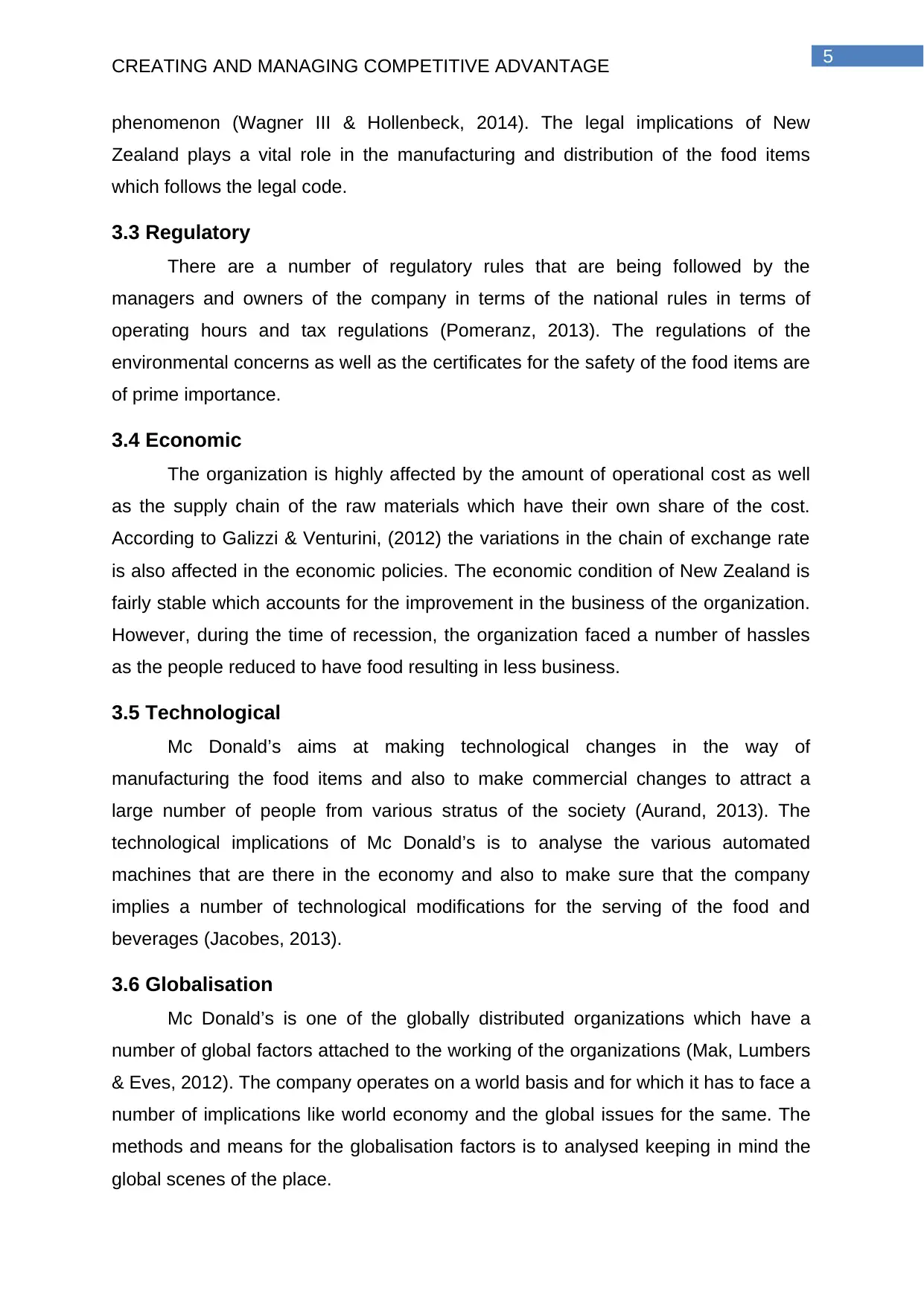
5
CREATING AND MANAGING COMPETITIVE ADVANTAGE
phenomenon (Wagner III & Hollenbeck, 2014). The legal implications of New
Zealand plays a vital role in the manufacturing and distribution of the food items
which follows the legal code.
3.3 Regulatory
There are a number of regulatory rules that are being followed by the
managers and owners of the company in terms of the national rules in terms of
operating hours and tax regulations (Pomeranz, 2013). The regulations of the
environmental concerns as well as the certificates for the safety of the food items are
of prime importance.
3.4 Economic
The organization is highly affected by the amount of operational cost as well
as the supply chain of the raw materials which have their own share of the cost.
According to Galizzi & Venturini, (2012) the variations in the chain of exchange rate
is also affected in the economic policies. The economic condition of New Zealand is
fairly stable which accounts for the improvement in the business of the organization.
However, during the time of recession, the organization faced a number of hassles
as the people reduced to have food resulting in less business.
3.5 Technological
Mc Donald’s aims at making technological changes in the way of
manufacturing the food items and also to make commercial changes to attract a
large number of people from various stratus of the society (Aurand, 2013). The
technological implications of Mc Donald’s is to analyse the various automated
machines that are there in the economy and also to make sure that the company
implies a number of technological modifications for the serving of the food and
beverages (Jacobes, 2013).
3.6 Globalisation
Mc Donald’s is one of the globally distributed organizations which have a
number of global factors attached to the working of the organizations (Mak, Lumbers
& Eves, 2012). The company operates on a world basis and for which it has to face a
number of implications like world economy and the global issues for the same. The
methods and means for the globalisation factors is to analysed keeping in mind the
global scenes of the place.
CREATING AND MANAGING COMPETITIVE ADVANTAGE
phenomenon (Wagner III & Hollenbeck, 2014). The legal implications of New
Zealand plays a vital role in the manufacturing and distribution of the food items
which follows the legal code.
3.3 Regulatory
There are a number of regulatory rules that are being followed by the
managers and owners of the company in terms of the national rules in terms of
operating hours and tax regulations (Pomeranz, 2013). The regulations of the
environmental concerns as well as the certificates for the safety of the food items are
of prime importance.
3.4 Economic
The organization is highly affected by the amount of operational cost as well
as the supply chain of the raw materials which have their own share of the cost.
According to Galizzi & Venturini, (2012) the variations in the chain of exchange rate
is also affected in the economic policies. The economic condition of New Zealand is
fairly stable which accounts for the improvement in the business of the organization.
However, during the time of recession, the organization faced a number of hassles
as the people reduced to have food resulting in less business.
3.5 Technological
Mc Donald’s aims at making technological changes in the way of
manufacturing the food items and also to make commercial changes to attract a
large number of people from various stratus of the society (Aurand, 2013). The
technological implications of Mc Donald’s is to analyse the various automated
machines that are there in the economy and also to make sure that the company
implies a number of technological modifications for the serving of the food and
beverages (Jacobes, 2013).
3.6 Globalisation
Mc Donald’s is one of the globally distributed organizations which have a
number of global factors attached to the working of the organizations (Mak, Lumbers
& Eves, 2012). The company operates on a world basis and for which it has to face a
number of implications like world economy and the global issues for the same. The
methods and means for the globalisation factors is to analysed keeping in mind the
global scenes of the place.
⊘ This is a preview!⊘
Do you want full access?
Subscribe today to unlock all pages.

Trusted by 1+ million students worldwide
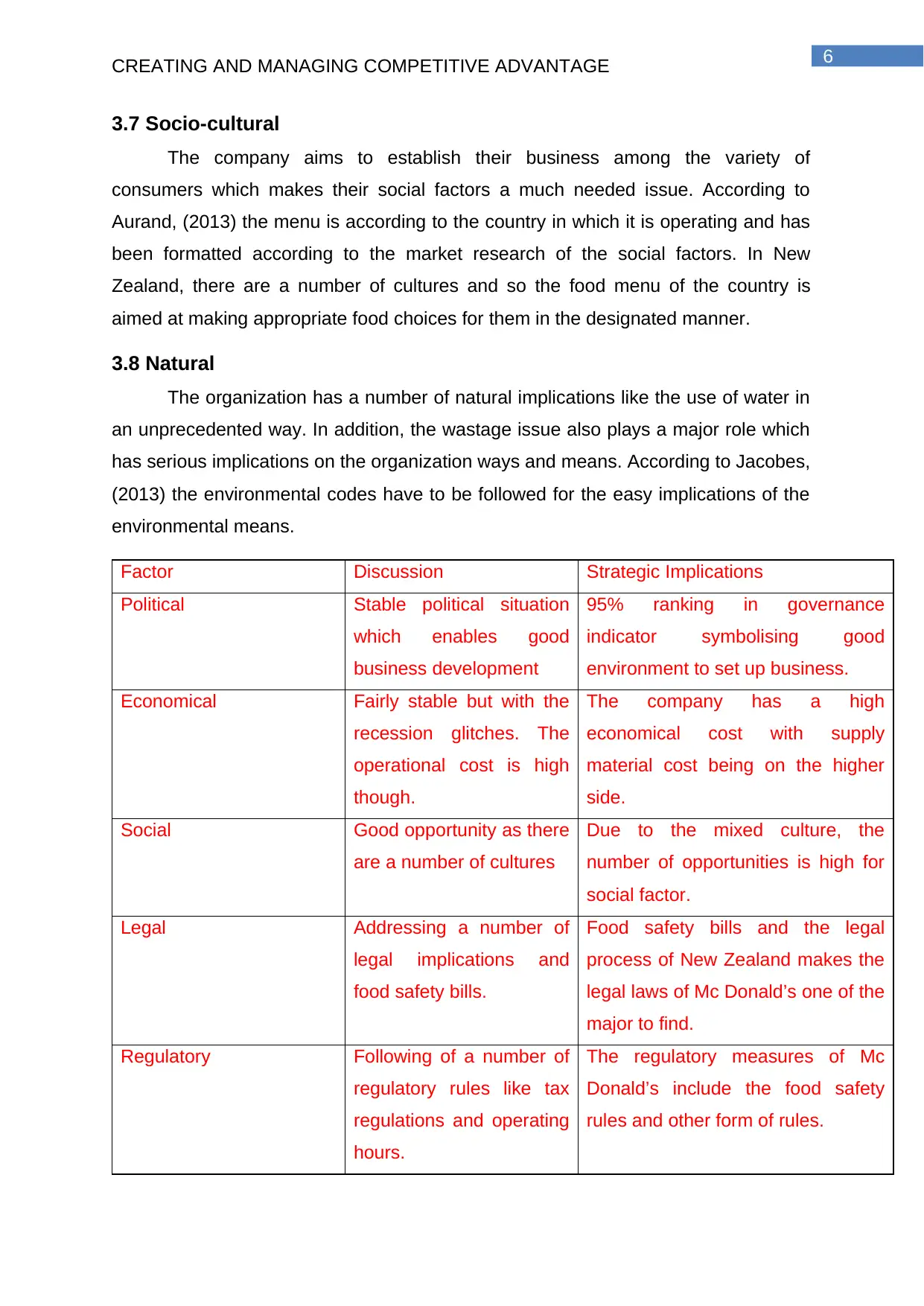
6
CREATING AND MANAGING COMPETITIVE ADVANTAGE
3.7 Socio-cultural
The company aims to establish their business among the variety of
consumers which makes their social factors a much needed issue. According to
Aurand, (2013) the menu is according to the country in which it is operating and has
been formatted according to the market research of the social factors. In New
Zealand, there are a number of cultures and so the food menu of the country is
aimed at making appropriate food choices for them in the designated manner.
3.8 Natural
The organization has a number of natural implications like the use of water in
an unprecedented way. In addition, the wastage issue also plays a major role which
has serious implications on the organization ways and means. According to Jacobes,
(2013) the environmental codes have to be followed for the easy implications of the
environmental means.
Factor Discussion Strategic Implications
Political Stable political situation
which enables good
business development
95% ranking in governance
indicator symbolising good
environment to set up business.
Economical Fairly stable but with the
recession glitches. The
operational cost is high
though.
The company has a high
economical cost with supply
material cost being on the higher
side.
Social Good opportunity as there
are a number of cultures
Due to the mixed culture, the
number of opportunities is high for
social factor.
Legal Addressing a number of
legal implications and
food safety bills.
Food safety bills and the legal
process of New Zealand makes the
legal laws of Mc Donald’s one of the
major to find.
Regulatory Following of a number of
regulatory rules like tax
regulations and operating
hours.
The regulatory measures of Mc
Donald’s include the food safety
rules and other form of rules.
CREATING AND MANAGING COMPETITIVE ADVANTAGE
3.7 Socio-cultural
The company aims to establish their business among the variety of
consumers which makes their social factors a much needed issue. According to
Aurand, (2013) the menu is according to the country in which it is operating and has
been formatted according to the market research of the social factors. In New
Zealand, there are a number of cultures and so the food menu of the country is
aimed at making appropriate food choices for them in the designated manner.
3.8 Natural
The organization has a number of natural implications like the use of water in
an unprecedented way. In addition, the wastage issue also plays a major role which
has serious implications on the organization ways and means. According to Jacobes,
(2013) the environmental codes have to be followed for the easy implications of the
environmental means.
Factor Discussion Strategic Implications
Political Stable political situation
which enables good
business development
95% ranking in governance
indicator symbolising good
environment to set up business.
Economical Fairly stable but with the
recession glitches. The
operational cost is high
though.
The company has a high
economical cost with supply
material cost being on the higher
side.
Social Good opportunity as there
are a number of cultures
Due to the mixed culture, the
number of opportunities is high for
social factor.
Legal Addressing a number of
legal implications and
food safety bills.
Food safety bills and the legal
process of New Zealand makes the
legal laws of Mc Donald’s one of the
major to find.
Regulatory Following of a number of
regulatory rules like tax
regulations and operating
hours.
The regulatory measures of Mc
Donald’s include the food safety
rules and other form of rules.
Paraphrase This Document
Need a fresh take? Get an instant paraphrase of this document with our AI Paraphraser
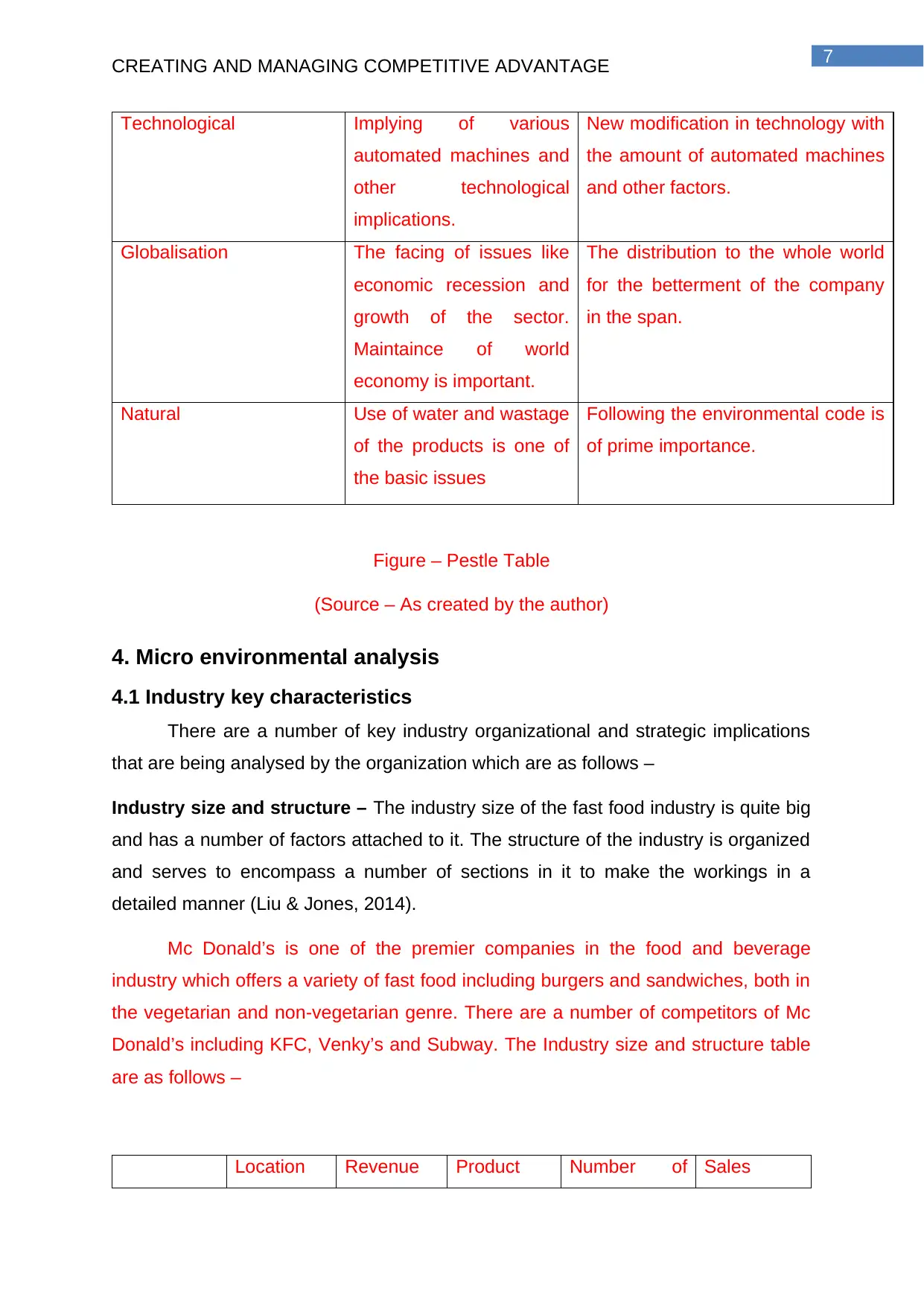
7
CREATING AND MANAGING COMPETITIVE ADVANTAGE
Technological Implying of various
automated machines and
other technological
implications.
New modification in technology with
the amount of automated machines
and other factors.
Globalisation The facing of issues like
economic recession and
growth of the sector.
Maintaince of world
economy is important.
The distribution to the whole world
for the betterment of the company
in the span.
Natural Use of water and wastage
of the products is one of
the basic issues
Following the environmental code is
of prime importance.
Figure – Pestle Table
(Source – As created by the author)
4. Micro environmental analysis
4.1 Industry key characteristics
There are a number of key industry organizational and strategic implications
that are being analysed by the organization which are as follows –
Industry size and structure – The industry size of the fast food industry is quite big
and has a number of factors attached to it. The structure of the industry is organized
and serves to encompass a number of sections in it to make the workings in a
detailed manner (Liu & Jones, 2014).
Mc Donald’s is one of the premier companies in the food and beverage
industry which offers a variety of fast food including burgers and sandwiches, both in
the vegetarian and non-vegetarian genre. There are a number of competitors of Mc
Donald’s including KFC, Venky’s and Subway. The Industry size and structure table
are as follows –
Location Revenue Product Number of Sales
CREATING AND MANAGING COMPETITIVE ADVANTAGE
Technological Implying of various
automated machines and
other technological
implications.
New modification in technology with
the amount of automated machines
and other factors.
Globalisation The facing of issues like
economic recession and
growth of the sector.
Maintaince of world
economy is important.
The distribution to the whole world
for the betterment of the company
in the span.
Natural Use of water and wastage
of the products is one of
the basic issues
Following the environmental code is
of prime importance.
Figure – Pestle Table
(Source – As created by the author)
4. Micro environmental analysis
4.1 Industry key characteristics
There are a number of key industry organizational and strategic implications
that are being analysed by the organization which are as follows –
Industry size and structure – The industry size of the fast food industry is quite big
and has a number of factors attached to it. The structure of the industry is organized
and serves to encompass a number of sections in it to make the workings in a
detailed manner (Liu & Jones, 2014).
Mc Donald’s is one of the premier companies in the food and beverage
industry which offers a variety of fast food including burgers and sandwiches, both in
the vegetarian and non-vegetarian genre. There are a number of competitors of Mc
Donald’s including KFC, Venky’s and Subway. The Industry size and structure table
are as follows –
Location Revenue Product Number of Sales
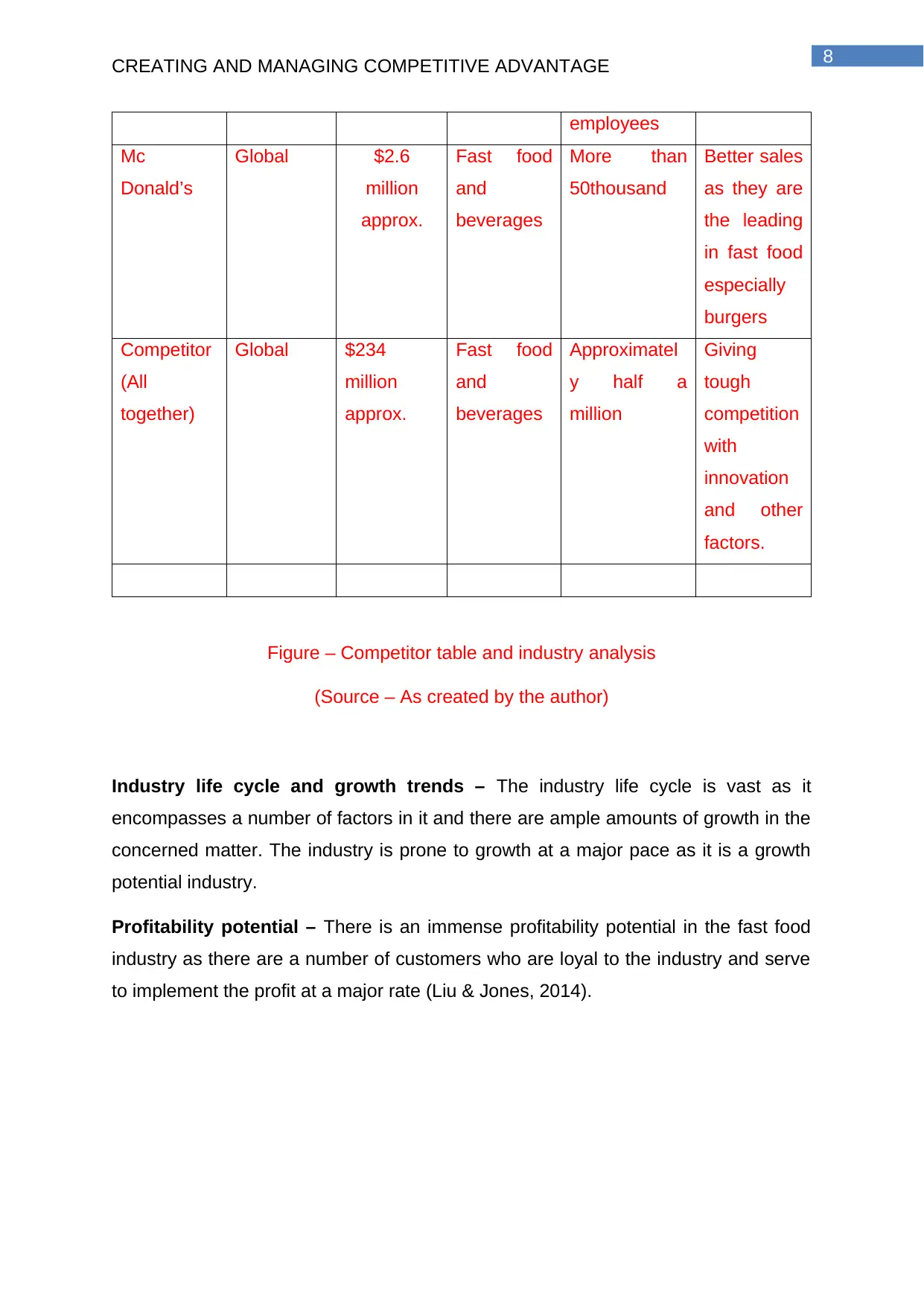
8
CREATING AND MANAGING COMPETITIVE ADVANTAGE
employees
Mc
Donald’s
Global $2.6
million
approx.
Fast food
and
beverages
More than
50thousand
Better sales
as they are
the leading
in fast food
especially
burgers
Competitor
(All
together)
Global $234
million
approx.
Fast food
and
beverages
Approximatel
y half a
million
Giving
tough
competition
with
innovation
and other
factors.
Figure – Competitor table and industry analysis
(Source – As created by the author)
Industry life cycle and growth trends – The industry life cycle is vast as it
encompasses a number of factors in it and there are ample amounts of growth in the
concerned matter. The industry is prone to growth at a major pace as it is a growth
potential industry.
Profitability potential – There is an immense profitability potential in the fast food
industry as there are a number of customers who are loyal to the industry and serve
to implement the profit at a major rate (Liu & Jones, 2014).
CREATING AND MANAGING COMPETITIVE ADVANTAGE
employees
Mc
Donald’s
Global $2.6
million
approx.
Fast food
and
beverages
More than
50thousand
Better sales
as they are
the leading
in fast food
especially
burgers
Competitor
(All
together)
Global $234
million
approx.
Fast food
and
beverages
Approximatel
y half a
million
Giving
tough
competition
with
innovation
and other
factors.
Figure – Competitor table and industry analysis
(Source – As created by the author)
Industry life cycle and growth trends – The industry life cycle is vast as it
encompasses a number of factors in it and there are ample amounts of growth in the
concerned matter. The industry is prone to growth at a major pace as it is a growth
potential industry.
Profitability potential – There is an immense profitability potential in the fast food
industry as there are a number of customers who are loyal to the industry and serve
to implement the profit at a major rate (Liu & Jones, 2014).
⊘ This is a preview!⊘
Do you want full access?
Subscribe today to unlock all pages.

Trusted by 1+ million students worldwide
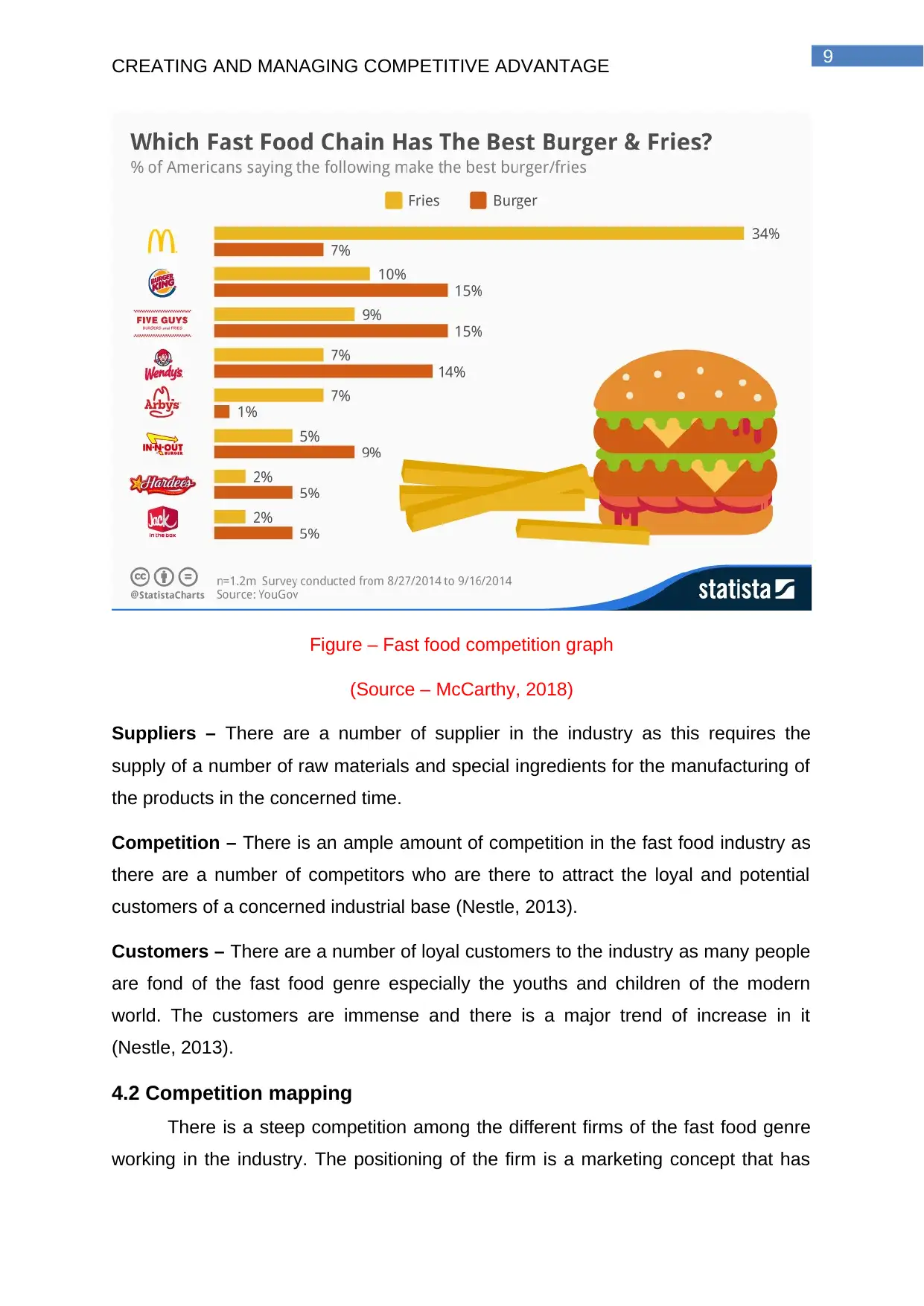
9
CREATING AND MANAGING COMPETITIVE ADVANTAGE
Figure – Fast food competition graph
(Source – McCarthy, 2018)
Suppliers – There are a number of supplier in the industry as this requires the
supply of a number of raw materials and special ingredients for the manufacturing of
the products in the concerned time.
Competition – There is an ample amount of competition in the fast food industry as
there are a number of competitors who are there to attract the loyal and potential
customers of a concerned industrial base (Nestle, 2013).
Customers – There are a number of loyal customers to the industry as many people
are fond of the fast food genre especially the youths and children of the modern
world. The customers are immense and there is a major trend of increase in it
(Nestle, 2013).
4.2 Competition mapping
There is a steep competition among the different firms of the fast food genre
working in the industry. The positioning of the firm is a marketing concept that has
CREATING AND MANAGING COMPETITIVE ADVANTAGE
Figure – Fast food competition graph
(Source – McCarthy, 2018)
Suppliers – There are a number of supplier in the industry as this requires the
supply of a number of raw materials and special ingredients for the manufacturing of
the products in the concerned time.
Competition – There is an ample amount of competition in the fast food industry as
there are a number of competitors who are there to attract the loyal and potential
customers of a concerned industrial base (Nestle, 2013).
Customers – There are a number of loyal customers to the industry as many people
are fond of the fast food genre especially the youths and children of the modern
world. The customers are immense and there is a major trend of increase in it
(Nestle, 2013).
4.2 Competition mapping
There is a steep competition among the different firms of the fast food genre
working in the industry. The positioning of the firm is a marketing concept that has
Paraphrase This Document
Need a fresh take? Get an instant paraphrase of this document with our AI Paraphraser
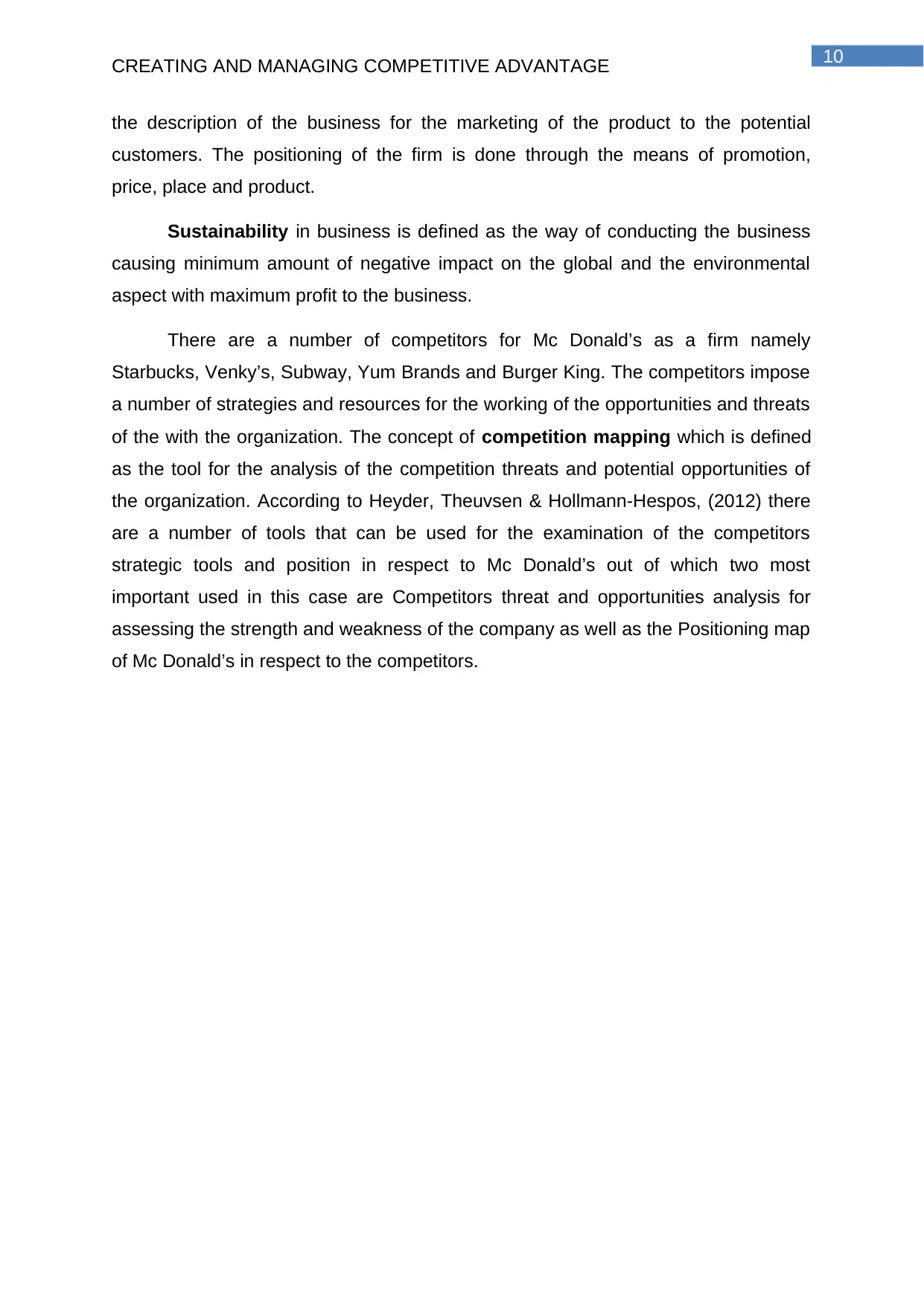
10
CREATING AND MANAGING COMPETITIVE ADVANTAGE
the description of the business for the marketing of the product to the potential
customers. The positioning of the firm is done through the means of promotion,
price, place and product.
Sustainability in business is defined as the way of conducting the business
causing minimum amount of negative impact on the global and the environmental
aspect with maximum profit to the business.
There are a number of competitors for Mc Donald’s as a firm namely
Starbucks, Venky’s, Subway, Yum Brands and Burger King. The competitors impose
a number of strategies and resources for the working of the opportunities and threats
of the with the organization. The concept of competition mapping which is defined
as the tool for the analysis of the competition threats and potential opportunities of
the organization. According to Heyder, Theuvsen & Hollmann-Hespos, (2012) there
are a number of tools that can be used for the examination of the competitors
strategic tools and position in respect to Mc Donald’s out of which two most
important used in this case are Competitors threat and opportunities analysis for
assessing the strength and weakness of the company as well as the Positioning map
of Mc Donald’s in respect to the competitors.
CREATING AND MANAGING COMPETITIVE ADVANTAGE
the description of the business for the marketing of the product to the potential
customers. The positioning of the firm is done through the means of promotion,
price, place and product.
Sustainability in business is defined as the way of conducting the business
causing minimum amount of negative impact on the global and the environmental
aspect with maximum profit to the business.
There are a number of competitors for Mc Donald’s as a firm namely
Starbucks, Venky’s, Subway, Yum Brands and Burger King. The competitors impose
a number of strategies and resources for the working of the opportunities and threats
of the with the organization. The concept of competition mapping which is defined
as the tool for the analysis of the competition threats and potential opportunities of
the organization. According to Heyder, Theuvsen & Hollmann-Hespos, (2012) there
are a number of tools that can be used for the examination of the competitors
strategic tools and position in respect to Mc Donald’s out of which two most
important used in this case are Competitors threat and opportunities analysis for
assessing the strength and weakness of the company as well as the Positioning map
of Mc Donald’s in respect to the competitors.
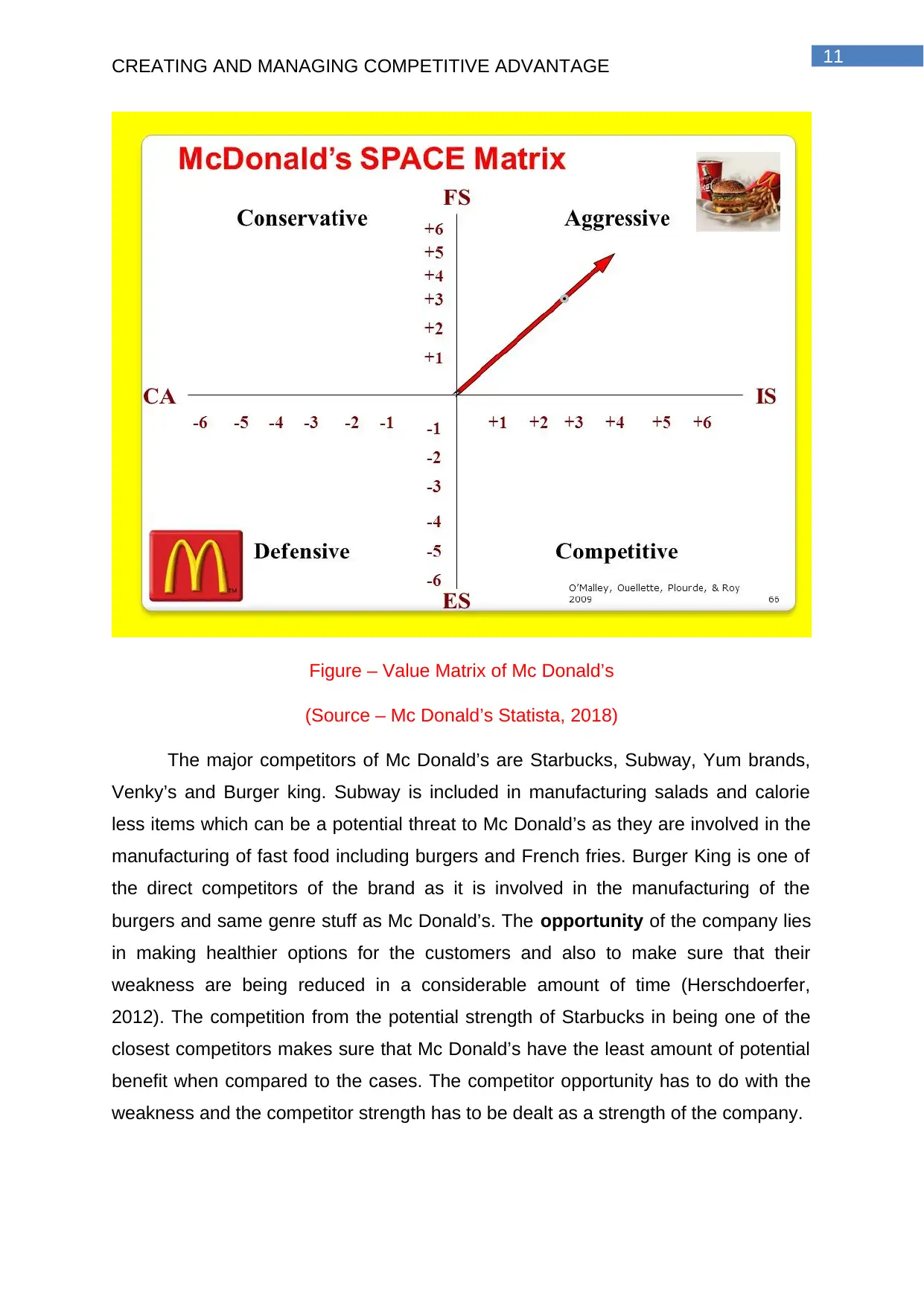
11
CREATING AND MANAGING COMPETITIVE ADVANTAGE
Figure – Value Matrix of Mc Donald’s
(Source – Mc Donald’s Statista, 2018)
The major competitors of Mc Donald’s are Starbucks, Subway, Yum brands,
Venky’s and Burger king. Subway is included in manufacturing salads and calorie
less items which can be a potential threat to Mc Donald’s as they are involved in the
manufacturing of fast food including burgers and French fries. Burger King is one of
the direct competitors of the brand as it is involved in the manufacturing of the
burgers and same genre stuff as Mc Donald’s. The opportunity of the company lies
in making healthier options for the customers and also to make sure that their
weakness are being reduced in a considerable amount of time (Herschdoerfer,
2012). The competition from the potential strength of Starbucks in being one of the
closest competitors makes sure that Mc Donald’s have the least amount of potential
benefit when compared to the cases. The competitor opportunity has to do with the
weakness and the competitor strength has to be dealt as a strength of the company.
CREATING AND MANAGING COMPETITIVE ADVANTAGE
Figure – Value Matrix of Mc Donald’s
(Source – Mc Donald’s Statista, 2018)
The major competitors of Mc Donald’s are Starbucks, Subway, Yum brands,
Venky’s and Burger king. Subway is included in manufacturing salads and calorie
less items which can be a potential threat to Mc Donald’s as they are involved in the
manufacturing of fast food including burgers and French fries. Burger King is one of
the direct competitors of the brand as it is involved in the manufacturing of the
burgers and same genre stuff as Mc Donald’s. The opportunity of the company lies
in making healthier options for the customers and also to make sure that their
weakness are being reduced in a considerable amount of time (Herschdoerfer,
2012). The competition from the potential strength of Starbucks in being one of the
closest competitors makes sure that Mc Donald’s have the least amount of potential
benefit when compared to the cases. The competitor opportunity has to do with the
weakness and the competitor strength has to be dealt as a strength of the company.
⊘ This is a preview!⊘
Do you want full access?
Subscribe today to unlock all pages.

Trusted by 1+ million students worldwide
1 out of 27
Related Documents
Your All-in-One AI-Powered Toolkit for Academic Success.
+13062052269
info@desklib.com
Available 24*7 on WhatsApp / Email
![[object Object]](/_next/static/media/star-bottom.7253800d.svg)
Unlock your academic potential
Copyright © 2020–2025 A2Z Services. All Rights Reserved. Developed and managed by ZUCOL.





